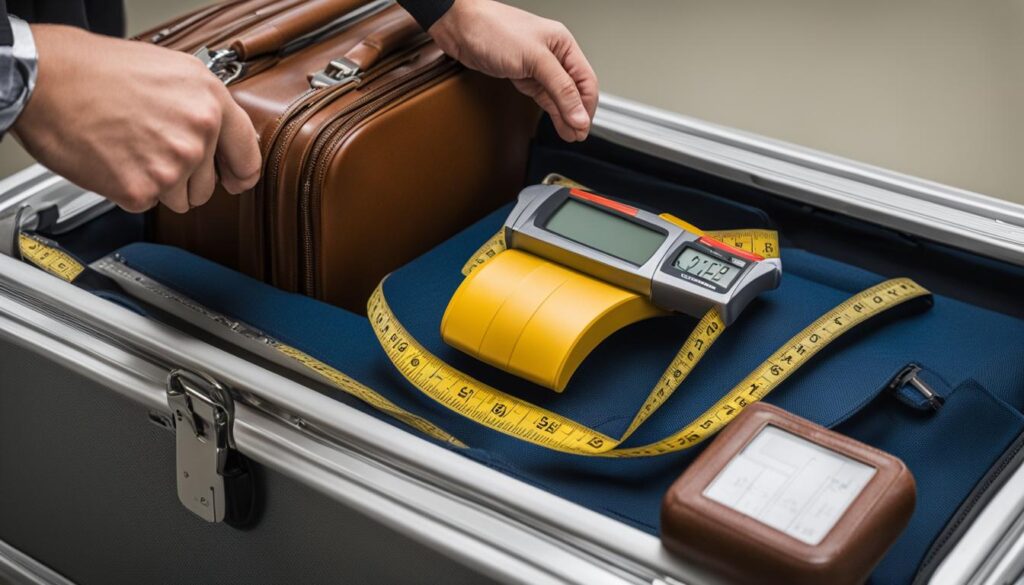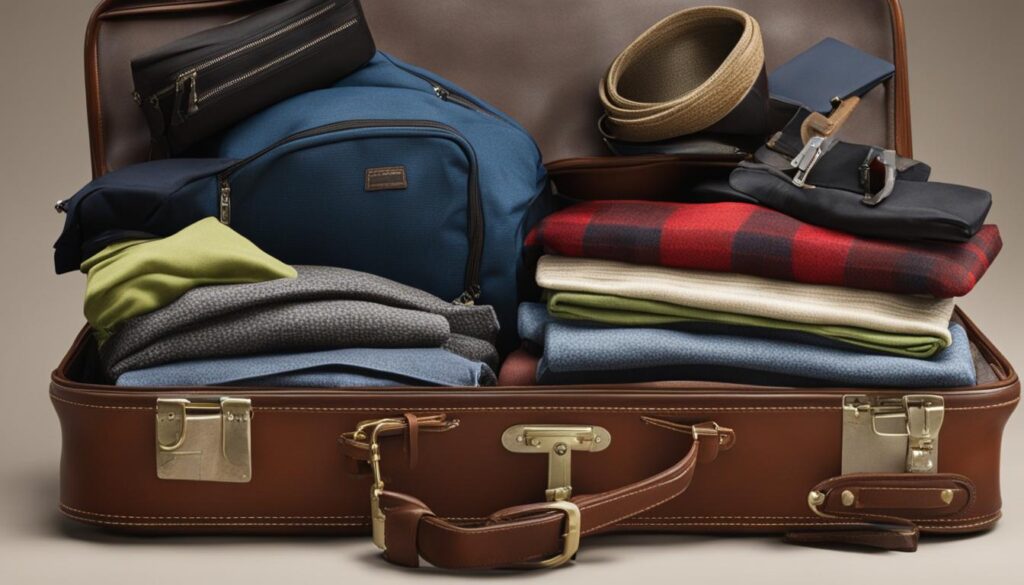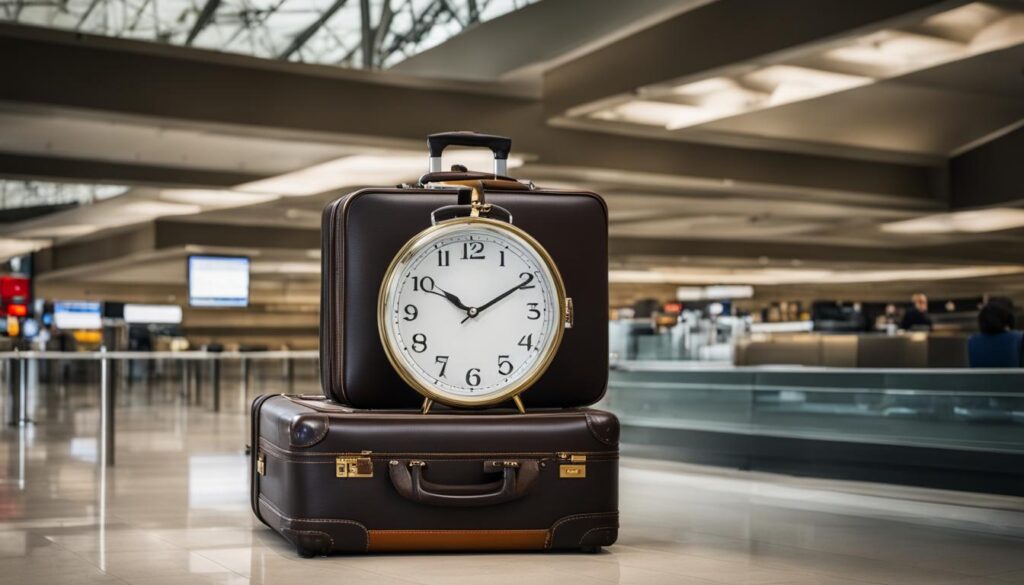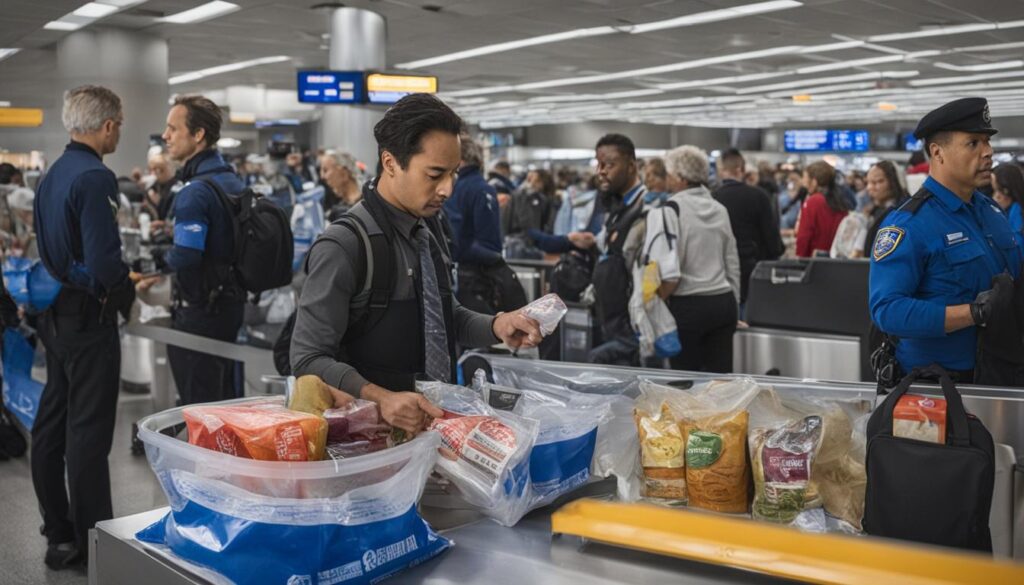Weighing your luggage before traveling can save you from the stress of excess baggage fees and ensure a hassle-free journey. Knowing the weight of your suitcase is especially crucial when flying, as airlines have specific weight limits for both checked and carry-on luggage. With the help of this guide, I will show you the methods to easily determine the weight of your suitcase and make informed packing decisions.
Key Takeaways:
- Knowing the weight of your suitcase is important to avoid excess baggage fees.
- Airlines have weight limits for both checked and carry-on luggage.
- Using a digital luggage scale is an easy and accurate method to weigh your suitcase.
- If you don’t have a digital scale, you can use a bathroom scale as an alternative method.
- Options for weighing luggage include scales at airports, supermarkets, and some hotels.
Why is it important to weigh luggage?
Weighing your luggage before traveling is a crucial step to avoid incurring excess baggage fees imposed by airlines. These fees can quickly add up and put a dent in your travel budget. By knowing the weight of your suitcase in advance, you can make informed packing decisions and ensure you stay within the weight limits set by the airline.
Most airlines have specific weight limits for both checked and carry-on luggage. Exceeding these limits can result in additional fees or the need to check your bag as oversized or overweight. By weighing your luggage beforehand, you can make adjustments to your packing and avoid any surprises or inconveniences at the airport.
Additionally, weighing your luggage allows you to plan and budget accordingly. By knowing the weight of your suitcase, you can determine if you need to remove any items or redistribute the weight among multiple bags to avoid overweight charges. This can help you save money and ensure a hassle-free travel experience.
Key points:
- Weighing your luggage helps you avoid excess baggage fees.
- Airlines have specific weight limits for checked and carry-on luggage.
- Weighing your luggage before traveling allows you to make informed packing decisions.
- Knowing the weight of your suitcase helps you plan and budget accordingly.
| Airline | Checked Luggage Weight Limit | Carry-On Luggage Weight Limit |
|---|---|---|
| Airline A | 50 lbs (23 kg) | 22 lbs (10 kg) |
| Airline B | 40 lbs (18 kg) | 18 lbs (8 kg) |
| Airline C | 55 lbs (25 kg) | 20 lbs (9 kg) |
Weighing your luggage is essential to avoid excess baggage fees and ensure a smooth travel experience. By knowing the weight limits set by airlines and making informed packing decisions, you can save money and avoid any surprises at the airport.
How to Weigh Luggage with a Hand Scale
Weighing your luggage before traveling is essential to avoid excess baggage fees and ensure a stress-free journey. One of the most convenient methods for weighing your luggage is to use a digital luggage scale. These portable devices are accurate and easy to use. Here’s how you can weigh your luggage with a hand scale:
- Set the scale to zero: Before attaching the scale to your suitcase, make sure it is set to zero. This ensures that the weight measurement is accurate.
- Attach the scale to your suitcase: Find a sturdy handle on your suitcase and securely attach the scale to it. Ensure that the scale is properly fastened to prevent any mishaps during the weighing process.
- Raise the luggage for a few seconds: Slowly lift the suitcase off the ground for a few seconds. Make sure it is balanced and steady to get an accurate measurement.
- Read the weight measurement: After holding the luggage for a few seconds, the weight measurement will be displayed on the scale. Take note of the weight for your reference.
Using a digital luggage scale is a quick and efficient way to determine the weight of your suitcase. By weighing your luggage before your trip, you can pack accordingly and avoid any surprises at the airport.
| Digital Luggage Scale | Advantages |
|---|---|
| Accuracy | Provides precise weight measurements for your luggage |
| Portability | Compact and lightweight, making it easy to carry during your travels |
| Convenience | Simple to use, allowing you to weigh your luggage at home or on the go |
Having a digital luggage scale is a valuable tool for any traveler. It ensures that you stay within the weight limits set by airlines and helps you avoid unnecessary fees for overweight baggage. By investing in a digital luggage scale, you can have peace of mind knowing the weight of your suitcase before heading to the airport.
“Weighing your luggage with a hand scale is a game-changer for travelers. It takes the guesswork out of packing and ensures you won’t be caught off guard by excess baggage fees. Plus, it’s so easy to use that anyone can do it!”
How to Weigh Luggage with a Bathroom Scale at Home
If you don’t have a digital luggage scale on hand, don’t worry! You can still accurately weigh your luggage using a bathroom scale as an alternative method. This can be especially useful if you’re looking to save money or don’t have access to a scale before your trip. Here’s a step-by-step guide on how to do it:
Gather Your Supplies
- Bathroom scale
- A sturdy object to elevate your luggage (such as a box or stack of books)
Make sure your bathroom scale is positioned on a flat, hard surface to ensure accurate measurements.
Weigh Yourself First
Step onto the bathroom scale and record your weight. It’s best to weigh yourself without any additional items, so wear minimal clothing.
Weigh Yourself with the Luggage
Next, grab your luggage and step back onto the scale, ensuring your luggage is supported by the sturdy object. Make sure both you and the luggage are balanced on the scale.
Calculate the Weight of the Luggage
Subtract your initial weight from the combined weight of you and the luggage to determine the weight of the suitcase. For example, if your initial weight is 150 pounds and the combined weight of you and the luggage is 165 pounds, then your suitcase weighs 15 pounds.
Keep in Mind
While using a bathroom scale as an alternative method can provide you with a rough estimate of your luggage’s weight, it’s important to note that it may not be as accurate as a digital luggage scale. The weight displayed on the bathroom scale may fluctuate slightly due to differences in how the luggage is balanced or distributed on the scale. It’s always a good idea to recheck the weight with a digital luggage scale if possible.
Using a bathroom scale can be a handy solution for weighing your luggage at home when you don’t have access to a dedicated digital luggage scale. Just remember to follow the steps carefully and keep in mind the limitations of using a bathroom scale for precise measurements. By accurately weighing your luggage, you can avoid any surprises at the airport and ensure a smooth travel experience.
Where Can You Weigh Luggage?
When it comes to weighing your luggage, there are various options available if you don’t have a scale at home. Here are some places where you can easily weigh your luggage:
1. Airports:
Many airports offer luggage weighing services for a small fee. These scales are usually located near the check-in counters or baggage drop areas. However, it’s recommended to weigh your luggage before arriving at the airport to avoid any surprises or last-minute adjustments.
2. Supermarkets:
Some supermarkets have scales available for public use. These scales are often found in the produce or deli sections of the store. Simply place your luggage on the scale and check the weight displayed. However, it’s important to note that supermarket scales may not be as accurate as dedicated luggage scales.
3. Hotels:
Certain hotels have digital hand scales or larger scales available at the concierge desk. You can inquire at the hotel front desk if they provide this service. It’s a convenient option if you’re staying at a hotel before heading to the airport.
By utilizing these options, you can easily weigh your luggage and ensure that you’re within the weight limits set by airlines. It’s always a good idea to weigh your luggage in advance to avoid any unexpected fees or hassle during check-in.
Checked baggage size and weight limits
When it comes to checked baggage, airlines have specific size and weight limits that passengers must adhere to. Exceeding these limitations can result in additional fees or the need to check the bag as oversized or overweight. It’s important to familiarize yourself with the requirements of the airline you are flying with to ensure a smooth check-in process and avoid any surprises at the airport.
To give you an idea of the general guidelines, I’ve compiled a table below that showcases the checked luggage size and weight limits for a few popular airlines:
| Airline | Size Limit | Weight Limit |
|---|---|---|
| Delta Air Lines | 62 inches (length + width + height) | 50 pounds |
| American Airlines | 62 inches (length + width + height) | 50 pounds |
| United Airlines | 62 inches (length + width + height) | 50 pounds |
Please note that these limits can vary between airlines, so it’s crucial to check with your specific airline for the most accurate and up-to-date information. Additionally, some airlines may have different size and weight restrictions for different fare classes or destinations, so it’s important to review the details of your ticket.
By ensuring your checked luggage falls within the size and weight limits set by the airline, you can avoid any potential issues during the check-in process and enjoy a hassle-free travel experience.

Carry-on Bag Size and Weight Restrictions
When traveling, it’s important to be aware of the size and weight restrictions for carry-on luggage. Each airline has its own guidelines, so it’s essential to check the specific requirements of the airline you are flying with. By knowing the carry-on limits, you can ensure that your luggage meets the criteria and avoid any inconveniences at the airport.
Most domestic flights have a maximum size limit for carry-on bags, typically around 22 x 14 x 9 inches. These dimensions include the wheels and handles of the suitcase. It’s important to note that if your carry-on bag exceeds the specified size, you may be required to check it in as a regular checked bag.
In addition to size restrictions, there may also be weight limits for carry-on luggage. International flights often have both size and weight requirements. The weight limit for carry-on bags can vary, but it is usually around 15 to 22 pounds. Exceeding the weight limit may result in additional fees or the need to check the bag as checked luggage. To ensure compliance, it’s advisable to pack light and weigh your carry-on bag before heading to the airport.
| Airline | Carry-On Size Limit (Inches) | Carry-On Weight Limit (Pounds) |
|---|---|---|
| Delta Air Lines | 22 x 14 x 9 | None specified, but should be manageable |
| United Airlines | 22 x 14 x 9 | None specified, but should be manageable |
| American Airlines | 22 x 14 x 9 | None specified, but should be manageable |
| Southwest Airlines | 24 x 16 x 10 | None specified, but should be manageable |
| JetBlue Airways | 22 x 14 x 9 | None specified, but should be manageable |
As seen in the table above, popular airlines generally have similar size limits for carry-on bags. It’s important to remember that weight limits may vary, and it’s best to refer to the specific guidelines of the airline you are traveling with to ensure compliance with their policies.
Personal Items Limitations
When traveling, it’s important to be aware of the size and weight restrictions for personal items. These items, such as purses, laptop bags, or small backpacks, are typically allowed to be carried onboard and placed under the seat in front of you. Airlines have specific guidelines to ensure that personal items fit within the limited space available in the cabin.
The size restrictions for personal items can vary between airlines, but they generally range from 9 inches x 10 inches x 17 inches to 9 inches x 14 inches x 22 inches. It’s essential to check the specific requirements of the airline you are flying with to ensure your personal item meets their guidelines. Paying attention to these dimensions will prevent any issues during the boarding process and ensure that your personal item is allowed on the plane.

Unlike checked baggage, weight restrictions for personal items are usually not specified by airlines. However, it’s still important to keep your personal item within a manageable weight. This ensures that you can easily handle it during your journey and prevent any strain or discomfort. It’s recommended to pack light and avoid overstuffing your personal item to maintain comfort and ease of movement.
“Knowing the size and weight limitations for personal items is crucial to ensuring a smooth and hassle-free travel experience. By adhering to these guidelines, you can avoid any potential issues at the airport and enjoy your journey with peace of mind.”
Packing Tips for Personal Items:
- Choose a personal item with multiple compartments or pockets to stay organized.
- Consider the functionality of your personal item, ensuring it is suitable for your needs during the flight.
- Pack essential items, such as travel documents, medication, and entertainment, in your personal item for easy access.
- Opt for lightweight materials when selecting a personal item to prevent unnecessary weight.
Summary
When traveling, it’s important to be aware of the size limitations for personal items. Airlines have specific guidelines to ensure that these items can be accommodated in the cabin without causing any disruptions or safety concerns. While weight restrictions may not be specified, it’s advisable to keep your personal item within a manageable weight to ensure ease of handling during your journey.
Tips for Packing Within Weight Limits
When it comes to packing your suitcase, staying within weight limits is essential to avoid excess baggage fees and ensure a smooth travel experience. To help you pack efficiently and effectively, here are some valuable tips:
1. Choose lightweight clothing and accessories
Opt for lightweight fabrics and versatile pieces that can be mixed and matched to create different outfits. This not only helps save space in your suitcase but also reduces overall weight. Consider packing items that can be layered for added warmth instead of bulky, heavy garments.
2. Wear heavier items during travel
Another useful strategy is to wear your heaviest clothing items and shoes during your journey. This frees up space and weight in your suitcase while keeping you comfortable during transit. It’s especially beneficial for bulky items like coats or boots that take up a significant amount of space.
3. Utilize compression bags
Compression bags are a traveler’s best friend when it comes to maximizing space and reducing weight. These airtight bags allow you to compress your clothing and remove excess air, resulting in a compact and lightweight package. They come in various sizes and are perfect for organizing different types of clothing.
4. Be mindful of souvenir weight
While it’s tempting to indulge in souvenir shopping during your trip, remember to consider the weight of the items you purchase. If you’re already nearing the weight limit, opt for lightweight and compact souvenirs. Alternatively, consider shipping heavier items back home to avoid exceeding weight restrictions.
By following these packing tips and being mindful of weight limits, you can ensure a hassle-free journey and avoid any unexpected fees at the airport. Remember to check the specific weight restrictions and guidelines of your chosen airline to plan accordingly. Happy travels!
Choose the Right Luggage for Your Needs
When it comes to selecting luggage for your travels, it’s important to consider the weight capacity of the suitcase. Choosing the right luggage that meets your needs and travel style can make a significant difference in your overall experience. Whether you’re a frequent traveler or embarking on a one-time journey, here are some key factors to consider:
1. Suitcase Weight Capacity
The weight capacity of your suitcase refers to the maximum amount of weight it can handle without risking damage or exceeding airline limitations. It’s crucial to choose a suitcase with a weight capacity that aligns with your packing requirements. Consider the duration of your trip, the type of items you’ll be carrying, and any potential weight restrictions imposed by airlines.
2. Material and Durability
Opt for a luggage material that strikes a balance between durability and weight. Hardshell suitcases are known for their ruggedness and ability to withstand rough handling during travel. However, they tend to be heavier than softshell options. On the other hand, softshell suitcases are lightweight and offer more flexibility in terms of expandability and storage options.
3. Size and Design
Select a suitcase size that suits your travel needs. Think about the duration of your trips and the number of belongings you typically carry. Keep in mind that larger suitcases may be more challenging to maneuver and may incur extra fees if they exceed airline size restrictions. Additionally, consider the design features that enhance convenience, such as multiple compartments, built-in TSA-approved locks, and smooth-rolling wheels.
4. Weight of the Luggage
While it’s essential to consider the weight capacity of your luggage, you should also pay attention to the weight of the luggage itself. Opting for a lightweight suitcase can help you make the most of your weight allowance for packing your belongings. Look for lightweight materials like polycarbonate or nylon, which offer durability without adding unnecessary weight.
| Suitcase Brand | Weight Capacity (in pounds) |
|---|---|
| Brand A | 40 |
| Brand B | 50 |
| Brand C | 30 |
Remember, it’s important to strike a balance between a suitcase’s weight capacity and its overall weight. Opt for a suitcase that not only meets your packing needs but also allows you to stay within the weight restrictions imposed by airlines.
By carefully considering the weight capacity, material, size, and weight of the luggage, you can select the perfect suitcase to accompany you on your travels. Ensure that your chosen luggage not only meets your needs but also complies with any weight limitations imposed by airlines for a hassle-free journey.
Conclusion
After reading this guide, weighing your luggage before traveling should no longer be a daunting task. By utilizing the various methods outlined in this article, such as using a hand scale or a bathroom scale, you can easily determine the weight of your suitcase and avoid any surprises at the airport.
Remember to familiarize yourself with the size and weight restrictions imposed by each airline for both checked and carry-on luggage. This knowledge will help you pack efficiently and stay within the allowed limits, thus avoiding excess baggage fees.
Choosing the right luggage that suits your needs, considering weight capacity, durability, and functionality, will ultimately make your travel experience smoother. By following these suitcase weight tips and being mindful of your packing choices, you can enjoy your trip without any unnecessary baggage-related troubles.
FAQ
Why is it important to weigh luggage?
Weighing your luggage helps you avoid excess baggage fees and ensure you stay within the weight limits imposed by airlines.
How do I weigh luggage with a hand scale?
To weigh luggage with a hand scale, set the scale to zero, attach it to a sturdy handle on your suitcase, and slowly raise the luggage for a few seconds to get an accurate measurement.
How can I weigh luggage with a bathroom scale at home?
Place the scale in an open area, weigh yourself first, then grab your luggage and step back onto the scale. Subtract your weight from the combined weight of you and the luggage to determine the weight of the suitcase.
Where can I weigh my luggage?
You can weigh your luggage at home using a hand scale or bathroom scale. Additionally, many airports have scales available for a fee, supermarkets often have public scales, and some hotels may have scales at the concierge desk.
What are the size and weight limits for checked baggage?
Each airline has its own limitations, but generally checked luggage should not exceed certain dimensions and there is usually a weight limit imposed as well. Exceeding these limits may result in additional fees or the need to check the bag as oversized or overweight.
What are the size and weight restrictions for carry-on bags?
Carry-on bag size and weight restrictions can vary depending on the airline. Domestic flights typically have a maximum size limit, while international flights may have both size and weight requirements. It’s important to check the guidelines of the airline you are flying with.
What are the limitations for personal items?
Personal items, such as a purse or laptop bag, must fit under the seat in front of you and have certain size limitations. While weight restrictions are generally not specified, it’s important to keep personal items within a manageable weight for ease of handling during the flight.
How can I pack within weight limits?
To pack within weight limits, consider packing lighter clothing and accessories, wearing heavier items during travel, using compression bags to save space, and being mindful of the weight of souvenirs or additional items purchased during your trip.
How do I choose the right luggage?
When selecting luggage, consider the weight capacity, opting for a lightweight suitcase with a higher weight capacity if you frequently travel with heavy items. Also, consider the durability and functionality of the luggage.




